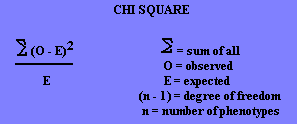Incomplete Dominance
Sometimes, when two different alleles of the same gene are joined together, a phenotype is produced that is not like either parent. For instance, a red flower is crossed to a white flower to produce a pink flower. The pink flower is heterozygous, and when it is self-pollinated, there will be 1 red, 2 pink, and 1 white flower.
Incomplete dominance (also known as partial dominance and co-dominance) is used for a variety of other traits such as chicken color, comb type, and horse color.
When working with incomplete dominance or any other type of inheritance, researchers can figure out whether the observed offspring is the same or similiar to the expected. The formula and interpretation of the results are as follows:

Then a chart is given in which chi square and the degree of freedom are figured. This will lead to a percent of accuracy.
- Continue to Incomplete Dominance Problem 1
- Return to Main Menu
|
|
© 2003-2026:
USA · USDA · NRPSP8 · Program to Accelerate Animal Genomics Applications.
|
||